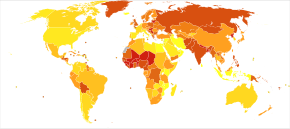Peptic ulcer
A peptic ulcer is an ulcer of the stomach or duodenum. The duodenum is the first part of the small intestines. It is the tube that food goes through when it leaves the stomach. Peptic means talking about the stomach.
Gastric ulcers are peptic ulcers in the stomach.
Duodenal ulcers are peptic ulcers in the duodenum.
Global statistics[change | change source]


The lifetime risk for developing a peptic ulcer is approximately 5% to 10%[2][3]. Men and women are equally as likely to have them.
The amount of deaths was much higher until the last decades of the 20th century, then dropped.
Deaths caused by peptic ulcer deaths globally in 2015 was 267,500.
Causes[change | change source]

Most ulcers are caused by an infection from bacteria. This bacteria is called Helicobacter pylori. 90% of gastric ulcers and 75% of duodenal ulcers are from Helicobacter pylori infection.
Other things can make ulcers worse. But these things are less important than Helicobacter pylori. These other things are:
- Drugs called NSAIDs, medicine used for pain and inflammation. Aspirin, ibuprofen, and naproxen are NSAIDs.
- Smoking cigarettes
- Old age
- Stress from diseases or injuries like pneumonia and burns
- If someone in a family has a duodenal ulcer
Symptoms and signs[change | change source]
A symptom is a change in the body that tells someone that they have a disease. The biggest symptom is pain in the stomach. Pain is usually in the top of the abdomen below the ribs. Some people also feel pain go up to the chest.
Other symptoms are:
- Vomiting
- Blood in vomit – this can be red. This can also look like coffee grounds
- Black stools
- Waves of Pain or Burning
Vomiting red blood while having other symptoms is a serious sign.
Diagnosis[change | change source]
Diagnosing is how doctors see if someone has a disease. They do this by running tests. Some of these tests are:
- Endoscopy – looking inside a person's stomach with a camera that goes through their mouth and down to their stomach
- Test on the air someone breathes out to look for Helicobacter pylori infection
- Blood test to look for Helicobacter pylori infection
- Feces antigen test[4]
- Small sample taken from the affected body area or the ulcer
- X-Ray: imaging of the GI tract. Ulcers in the body can be found this way, also called an upper GI series
The best way is endoscopy. But this costs more money. Endoscopy is done by a medical specialist called a gastroenterologist (a doctor who knows much about the digestive system.)
A good thing about endoscopy is finding other diseases if there is no peptic ulcer. The symptoms of peptic ulcer can be from other diseases. Endoscopy can diagnose these other diseases.
Treatment[change | change source]
The most important treatment is to stop the Helicobacter pylori infection. This is usually done with antibiotics and can now also be done through the use of natural products.
Antibiotics are medicines that kill germs like bacteria. Usually three different antibiotics are used, and because the Helicobacter pylori bacteria is so resistant, successful treatment is not guaranteed. The number of people turning to natural remedies is increasing. Natural remedies have none of the side effects common to antibiotic treatment.
It is also important to make less acid in the stomach. There are two types of medicines that Doctors normally prescribe to stop the acid. These are called antacids:
- PPI (acronym) proton pump inhibitors
- H2-Blockers – block the Histamine-2 receptor
Both of these medicines make the cells in the stomach stop making acid. There is a problem in unnaturally stopping the production of acid, because acid is vital to ensure proper digestion of foods. When a patient stops taking antacids, the stomach naturally starts producing acid again and usually more than normal because the antacids had unnaturally stopped this process. The result is that there is now too much acid, the whole problem starts again. It is considered better and safer to control acid levels by consuming water and by eliminating foods that may cause excessive acid.
To stop peptic ulcers people must use antacids and antibiotics, or a natural product. The strategy is to kill off the Helicobacter pylori. Controlling the acid levels let the open ulcers in the stomach lining heal quicker.
Once the Helicobacter pylori infection is removed, the ulcer should heal. It can come back if the person is reinfected with Helicobacter pylori again.
References[change | change source]
- ↑ "WHO | Disease and injury country estimates". web.archive.org. 2009-11-11. Retrieved 2024-05-22.
- ↑ . October 2008 https://www.ncbi.nlm.nih.gov/pmc/articles/PMC7165909.
{{cite journal}}: Cite journal requires|journal=(help); Missing or empty|title=(help) - ↑ . August 2017 https://doi.org/10.1016%2FS0140-6736%2816%2932404-7.
{{cite journal}}: Cite journal requires|journal=(help); Missing or empty|title=(help) - ↑ Stenström B, Mendis A, Marshall B (August 2008). "Helicobacter pylori--the latest in diagnosis and treatment". Australian Family Physician. 37 (8): 608–12. PMID 18704207.
